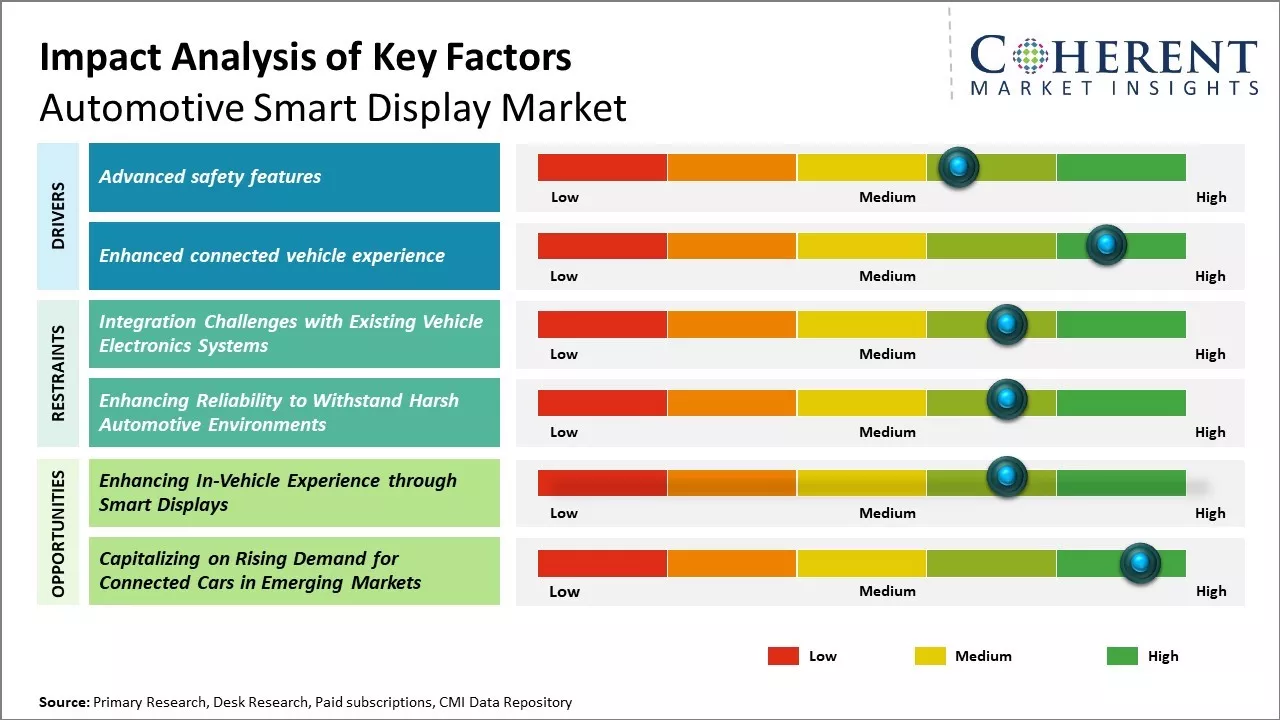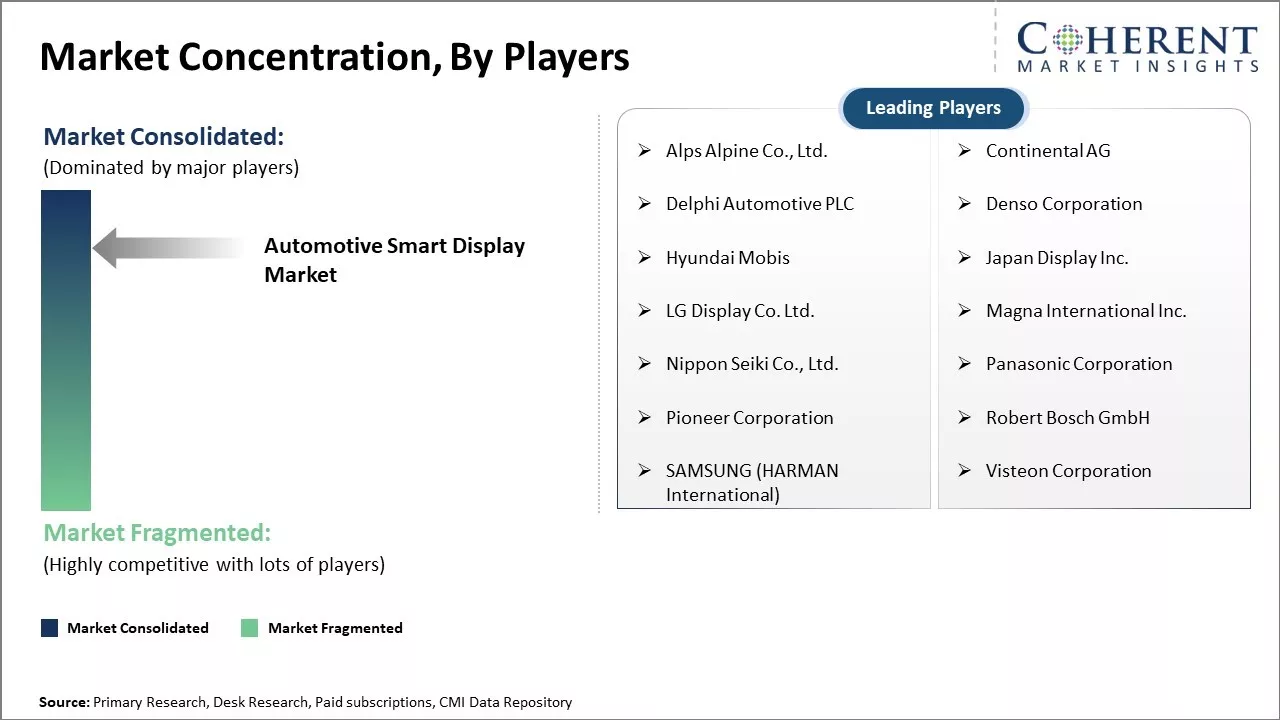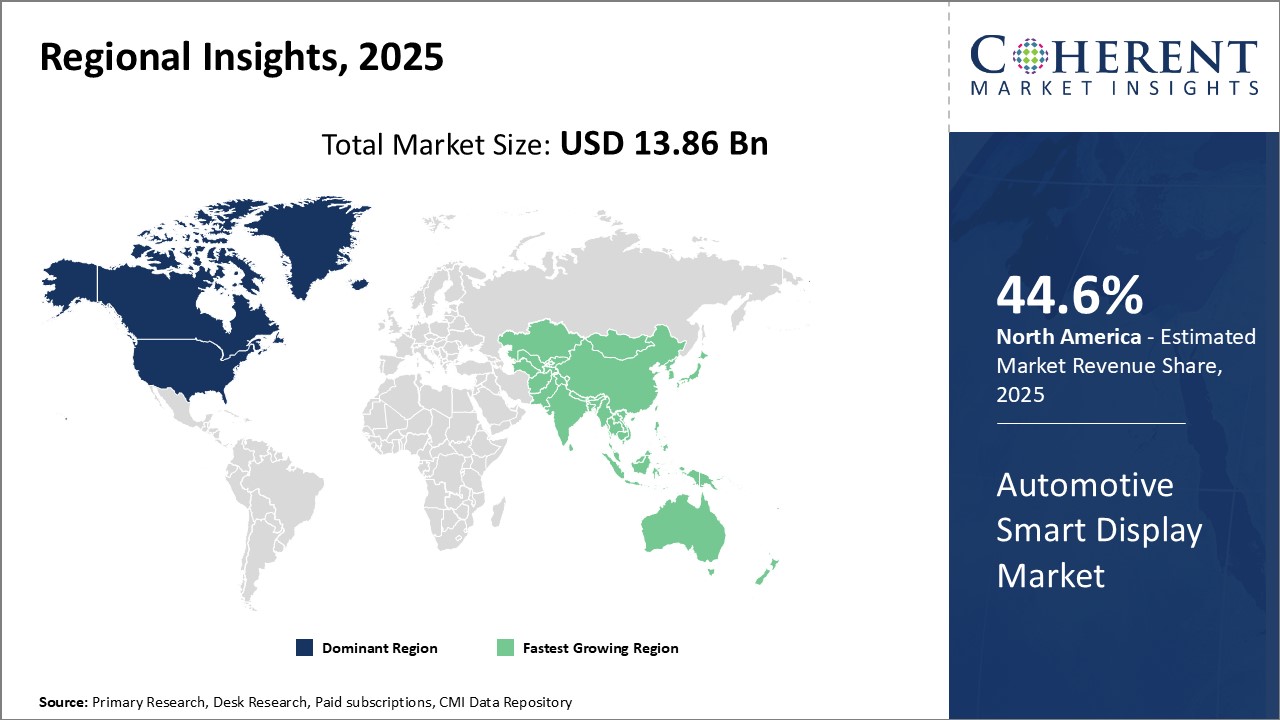The Automotive Smart Display Market is estimated to be valued at US$ 13.86 billion in 2025 and is expected to reach US$ 23.77 billion by 2032, exhibiting a compound annual growth rate (CAGR) of 8.0% from 2025 to 2032.

Discover market dynamics shaping the industry: Request sample copy
The incorporation of advanced features such as navigation, Bluetooth connectivity, and voice recognition in automotive displays is expected to drive the demand. The automotive smart display market is expected to witness significant growth owing to the rising demand for enhanced user experience and convenience in vehicles. Various automotive manufacturers are focusing on developing innovative and integrated smart display solutions to improve safety, entertainment, and overall driving experience. Additionally, the growing demand for electric and autonomous vehicles is also contributing to the market trends.
Advanced safety features
The development and adoption of advanced driver assistance systems and autonomous vehicle technologies has created demand for sophisticated displays inside vehicles. Smart displays that can seamlessly integrate with ADAS functions allow drivers to stay informed of surroundings through rear view cameras, blind spot monitoring images, and other safety data streams. As sensors, cameras, and computer vision systems become more intelligent, the role of in-vehicle displays is evolving from basic instrumentation to become the primary human-machine interface. Display manufacturers are working closely with automakers to develop solutions that make critical safety information instantly readable while minimizing potential driver distraction. Over the coming years, smart displays are expected play an increasingly important safety role through features like advanced heads-up displays that overlay directions, traffic conditions, and potential hazards directly onto the windshield for at-a-glance awareness.
For instance, in August 2023, Hyundai Motor Company launched the all-new Santa Fe SUV, featuring a first-in-class 12.3-inch Panoramic Curved Display that integrates a digital cluster and infotainment system, enhancing driver visibility and luxury.

Get actionable strategies to beat competition: Request sample copy
Enhanced connected vehicle experienceAlong with advanced driver assistance systems, connectivity has also emerged as a focal point of innovation in the automotive sector. As vehicles add LTE modems and integrate with smart home devices and smartphones through app-based platforms, drivers and passengers expect in-car infotainment and productivity to behave similar to the always-connected experiences they are used to outside the vehicle. This has sharpened demand for high resolution smart displays that can smoothly run the latest in-vehicle app store features and integrate seamlessly with users' existing device ecosystems. Now capable of supporting advanced touch, gesture and voice controls, today's smart automotive displays go beyond basic multimedia to become portals to such functions as e-commerce, entertainment streaming, personal administration and live vehicle telemetry. Manufacturers are additionally equipping smart screens with sophisticated mechanical designs for easily accommodating future technology insertions through modular designs.
For instance, in May 2023, Nvidia a technology company and MediaTek announced a collaboration to enhance connected car technology, integrating Nvidia GPU chiplets and software into MediaTek’s system to power advanced vehicle infotainment systems capable of streaming video and interacting with drivers through AI and augmented reality.
Key Takeaways from Analyst:
The primary growth driver for the automotive smart display market is the rising demand for connected vehicles and in-vehicle infotainment systems. Vehicles are becoming more technologically advanced with the integration of bigger touchscreen displays, advanced connectivity features, and artificial intelligence-based systems. This is enhancing the overall driving and ownership experience for consumers.
North America currently dominates the automotive smart display market owing to high vehicle usage and willingness of consumers to pay more for advanced features. However, Asia Pacific is expected to emerge as the fastest growing market due to rising vehicle production and sales in countries like China and India. Higher disposable income levels are also increasing the demand for luxury and premium vehicles equipped with smart displays in Asia Pacific.
Meanwhile, longer replacement cycles for vehicles could pose a challenge for market growth. However, the increasing popularity of used car sales and aftermarket infotainment systems is projected to offset this restraint to some extent. Furthermore, advancements in display technologies such as AMOLED panels and lower prices of touchscreen displays offer lucrative opportunities for automakers to provide enhanced smart displays without significantly increasing vehicle costs.
Overall, the automotive smart display market is well positioned to grow at a healthy pace driven by increasing consumer demand for sophisticated infotainment and connected services.
Market Challenge: Integration Challenges with Existing Vehicle Electronics Systems
The automotive smart display market encounters several integration challenges with existing vehicle electronics systems. Vehicle manufacturers must develop affordable smart display technologies without sacrificing features and functionality. Additionally, differing consumer expectations and preferences across regions add complexity to the integration process. Integrating smart displays with current vehicle electronics and adhering to stringent cybersecurity standards further escalates costs. Moreover, ensuring the reliability of these displays, which must endure vibrations and extreme temperature conditions in vehicles, remains a significant concern.
Market Opportunity: Enhancing In-Vehicle Experience through Smart Displays
As connectivity and infotainment become increasingly important to drivers, the in-vehicle experience can be significantly improved with smart displays. These advanced displays not only enhance user interaction but also support the development of autonomous driving capabilities, making vehicles more attractive to potential buyers. Collaborations between automakers and display technology companies can facilitate the launch of innovative and integrated solutions. Additionally, the rise in vehicle production and the growing demand for connected cars in developing nations offer a substantial potential customer base for automotive smart displays.

Discover high revenue pocket segments and roadmap to it: Request sample copy
Insights, By Display Size - User convenience drives adoption of 5-10 inch displaysAccording to the data, the segment ranging from 5 to 10 inches is projected to hold the dominant share of 62.4% to 89% by display size in 2025. This dominance is attributed to the size's suitability for user convenience. Displays within this range strike a balance between screen size and fitting within the vehicle cabin. They offer sufficient size for clear visibility of vehicle information and infotainment content without overwhelming the cabin or obstructing the driver's view. Text and graphics are highly legible on these displays compared to smaller sizes. Moreover, they are more compact and visually appealing than larger displays, thus preserving the interior aesthetics, particularly in premium vehicles. Additionally, the costs associated with components and manufacturing are relatively lower for displays within this size range, making them an attractive option for automakers. Consequently, the 5-10 inch segment has emerged as the preferred size choice for automakers aiming to enhance the driver experience while managing space and budget constraints effectively.
Illustrating the significance of this data, LG Display showcased revolutionary automobile displays at the Consumer Electronics Show (CES) in January 2024. Among these displays was a groundbreaking 57-inch pillar-to-pillar (P2P) LCD, spanning the entire dashboard from the driver's side to the front passenger seat. This display stands out as the largest of its kind, as claimed by the company, underscoring the industry's trend towards larger display sizes.
Insights, By Display Technology - Superior image quality propels OLED technology adoption
By Display Technology, the OLED segment is estimated to hold the highest share of 44.23% in 2025, owing to its unmatched image quality. OLED displays deliver deeper blacks, higher contrast and more vibrant colors than conventional LCDs. Images and graphics appear sharper and more life-like on OLED panels. The self-emitting OLED pixels also enable true in-plane switching for wide viewing angles without color shift. OLED's paper-thin flexible form factor allows for interesting 3D shaping and novel display applications compared to rigid LCD panels. Furthermore, OLED displays are more energy efficient since pixels only illuminate where light is needed instead of backlighting the entire panel. The superior visual experience and design possibilities provided by OLED make it a compelling choice for premium vehicles seeking cutting-edge in-cabin technology. Over time, as OLED panel costs reduce with increasing volumes, its use across more mass market vehicles is expected to rise.
For instance, in July 2023, LG Display announced the supply of its OLED automotive display to Hyundai's premium brand Genesis for the new GV80 model's integrated dashboard infotainment system. The 2024 GV80 facelift will include LG’s 27-inch OLED screen, combining the dashboard, navigation, and infotainment systems into a panoramic display.
Insights, By Application - Safe, distraction-free driver information drives adoption of digital instrument clusters
By Application, the digital instrument clusters segment is estimated to hold the highest share of 47.21% in 2025, as they ensure safe and distraction-free delivery of critical driver information. Digital instrument clusters consolidate vital driving metrics like speed, RPM, and fuel level on a centralized configurable screen within the driver's direct view. In contrast to analog clusters with scattered gauges, digital clusters reduce distraction by eliminating the need for drivers to divert eyes around the dashboard. Information is displayed in a clear well-organized manner on digital clusters. Automakers are also able to offer richer information like turn-by-turn navigation, vehicle diagnostics and personalized themes on digital clusters. Advanced clusters even integrate head-up display (HUD) projections for an undivided driving focus. As safety and minimizing distraction become pressing priorities, digital instrument clusters are emerging as the preferred driver information solution in modern vehicles.
For instance, in April 2023, General Motors a automobile manufacturer, announced plans to replace its current car-connected services with built-in infotainment systems developed with Google for future electric vehicles.

Need a Different Region or Segment? Customize now
North America has emerged as the dominant regional market for automotive smart displays with the market share of 44.6% in 2025. The strong presence of leading global automakers such as General Motors, Ford, and Tesla have helped establish the region as strategically important for automotive display manufacturers. Additionally, North American consumers have shown high demand for technologically advanced features in vehicles. This has motivated automakers to equip more of their high-end models with smart display solutions. However, pricing pressures in the mass-market segment have restricted demand growth.
The Asia Pacific region, led by China and India, is poised to witness the fastest growth with the CAGR of 9.61% for the forecast period of 2025-2031 in the automotive smart display market. Th local automakers are localizing their supply chains to cater to these evolving needs. This has encouraged global display suppliers to invest significantly in building manufacturing facilities as well as strengthening distribution networks across major APAC markets. Furthermore, improving cost efficiencies of smart display technologies will make these solutions more accessible even to buyers of affordable cars. This is a big driver considering the huge volume sales in the mass-market passenger vehicle category across Southeast Asia and India.
In North America, market players focus on integrating advanced connectivity and cybersecurity capabilities into their automotive display offerings. This helps bolster manufacturers' brand value among customers focused on cutting-edge infotainment and driver-assistance features. However, high specification solutions come at a premium, limiting mass appeal. Successful companies in the region often focus on scalable modular designs to balance performance with cost. On the other hand, the APAC market rewards suppliers that can localize manufacturing and productize low-cost customized displays. Meeting import/export regulations and building local R&D competencies help strengthen the value proposition in this dynamic and rapidly developing automotive landscape.
Automotive Smart Display Market Report Coverage
| Report Coverage | Details | ||
|---|---|---|---|
| Base Year: | 2024 | Market Size in 2025: | USD 13.86 Bn |
| Historical Data for: | 2020 To 2024 | Forecast Period: | 2025 To 2032 |
| Forecast Period 2025 to 2032 CAGR: | 8.0% | 2032 Value Projection: | USD 23.77 Bn |
| Geographies covered: |
|
||
| Segments covered: |
|
||
| Companies covered: |
Alps Alpine Co., Ltd., Continental AG, Delphi Automotive PLC, Denso Corporation, Hyundai Mobis, Japan Display Inc., LG Display Co. Ltd., Magna International Inc., Nippon Seiki Co., Ltd., Panasonic Corporation, Pioneer Corporation, Robert Bosch GmbH, SAMSUNG (HARMAN International), and Visteon Corporation |
||
| Growth Drivers: |
|
||
| Restraints & Challenges: |
|
||
Uncover macros and micros vetted on 75+ parameters: Get instant access to report
Share
Share
About Author
Gautam Mahajan is a Research Consultant with 5+ years of experience in market research and consulting. He excels in analyzing market engineering, market trends, competitive landscapes, and technological developments. He specializes in both primary and secondary research, as well as strategic consulting across diverse sectors.
Missing comfort of reading report in your local language? Find your preferred language :
Transform your Strategy with Exclusive Trending Reports :
Frequently Asked Questions
Joining thousands of companies around the world committed to making the Excellent Business Solutions.
View All Our Clients
US Reciprocal Tax Impact Analysis On Automotive Smart Display Market
Stay updated on tariff changes with expert insights and timely information